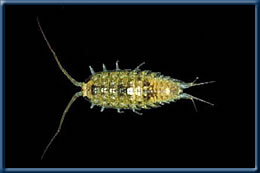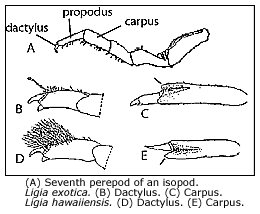

Balanus amphitrite

Balanus eburneus

Chthamalus proteus

Gonodactylaceus falcatus

Ligia exotica

Pachygrapsus fakaravensis

Scylla serrata
Ligia exotica
 Wharf
Roach
Wharf
Roach
Phylum Arthropoda
Subphylum Crustacea
Class Malacostraca
Superorder Peracarida
Order Isopoda
Family Ligiidae
Description
This large gray-brown isopods can grow to about 3 cm. It has large bulging
eyes and long antennae and uropoda. Smaller individuals can be confused
with Ligia hawaiiensis, an endemic species.
They can be distinguished by an examination of the last leg (seventh pereopod).
The dactylus of L. hawaiiensis has long setae,
while that of L. exotica does not. Also the
carpus of L. hawaiiensis has a process which
extends past the distal margin of the appendage (Tahiti and Howarth, in
prep.).
 Habitat
Habitat
Found scurrying on rocks and pilings above the water line in harbors.
Distribution
Hawaiian Islands
Honolulu Harbor, Oahu and Hilo Harbor, Hawaii
Native Range
Northeastern Atlantic and Mediterranean
Present Distribution
In harbors of warm and temperate seas worldwide.
Mechanism of Introduction
Unintentional, carried by ships.
Impact
Ecological impact unstudied, but competition with the native Ligia hawaiiensis
is likely.
Ecology
Feeding
Ligia exotica is a scavenger, feeding on
detritus and plant debris.
Reproduction
With separate sexes. Fertilization is internal. Females lay eggs in in
cracks and crevices in the intertidal zone.
Remarks
A recent (1996) collection of this species at Hilo represents the first
valid record of L. exotica from the Hawaiian
Islands. The specimens were examined and identified by Stephano Taiti.
Previous records of L. exotica from Hawaii
by Robertson, Edmondson, Van Name, and others, are all based on Ligia
hawaiiensis, an endemic species (Taiti, pers comm.)
References
Taiti, S. and F. Howarth (in prep.) A key to the terrestrial isopods of
Hawaii.
© 2002 Hawaii Biological Survey, Bishop Museum
contact